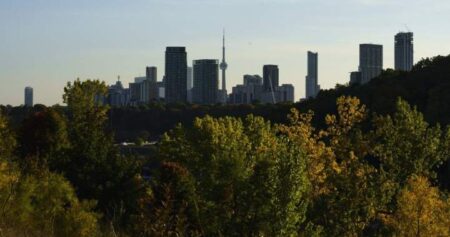A polar vortex is on its way for much of Canada next week.
And while it’s not the first time Canadians have faced down the chill of a polar vortex in recent years, this one is set to cause temperatures to plunge below what many are used to this time of year.
“Computer models and analogs looking at past years with similar November weather patterns are all pointing towards a colder-than-normal December in Canada,” said Global News meteorologist Anthony Farnell.
What should you expect?
The polar vortex exists year-round and generally surrounds the Earth’s poles.
“Sometimes this vortex expands or stretches and is forced southward away from the North Pole,” said Farnell.
“This sends abnormally cold and stormy weather into the more populated regions of North America, along with Europe and Asia. These ‘polar vortex’ episodes can last anywhere from days to a few weeks.”
It is essentially a “wide expanse of swirling cold air,” according to the U.S. National Oceanic and Atmospheric Administration (NOAA). The Arctic polar vortex surrounds the North Pole around 10-30 metres above the surface of the Earth.
When this low-pressure system is strong, it keeps the jet stream circling the Earth. However, during winter, the polar vortex at the North Pole expands, sending cold air southward.
“As this system weakens, some of the cold, arctic air can break off and migrate south, bringing plenty of cold air with it. Areas as far south as Florida may experience arctic weather as a result,” NOAA says on its website.
Winter doesn’t officially start until Dec. 21.
But the arrival of the polar vortex “will likely mean a harsh early start to winter across the country,” Farnell said.

Get breaking National news
For news impacting Canada and around the world, sign up for breaking news alerts delivered directly to you when they happen.
The frigid Arctic air is already starting to appear across Western Canada, bringing snowy conditions to parts of southern Alberta and Saskatchewan.
Heavy snow that blanketed the City of Calgary overnight made many roads virtually impassable as vehicles slid down hills and crashed into each other, prompting police to shut down some streets while emergency crews worked to clear away damaged vehicles and debris.
A large area stretching from southeastern British Columbia into southern Saskatchewan was under a heavy snowfall warning, with up to 20 cm of snow expected to fall in some areas.
Environment Canada currently has a winter storm watch for large parts of northern Ontario, including Thunder Bay and Timmins.
The snow is forecast to taper off late Monday in B.C. and Alberta, and Tuesday morning in Saskatchewan.
This will lead to rain showers over the Great Lakes turning into flurries next week, Farnell said.
“Initially, the pattern looks to have some big swings in temperature with cold mixing with milder days in the eastern part of the country through the first few days of December. The western half of Canada is more likely to lock in to below seasonal temperatures this week and stay that way through much of December,” he added.
Environment Canada warned that strong winds will also create blowing snow, reducing visibility and making travel challenging for motorists.
The risk of “extreme cold” arrives in December, Farnell said, adding that computer models show a further displacement of the polar vortex is likely.
“With the Great Lakes still unfrozen, it would also lead to days of lake effect piling up,” he said.
The year 2025 seems to be bookended by polar vortexes, after a rush of Arctic air left temperatures plummeting in January of this year.
The Prairies in particular saw wind chills near -40 C or lower for Saskatoon, Regina and Winnipeg during that polar vortex earlier in the year.
A polar vortex in 2021 extended deep into the United States as well, with cold warnings across multiple states and an ice storm in Texas.
The polar vortexes that hit Canada in 2013-2014 brought dangerously low temperatures. That year, some areas near Regina saw temperatures lower than the surface of Mars, Environment Canada said.
The disruptions can be quite sudden. On New Year’s Day 2014, Ottawa went from slushy puddles and melting temperatures to -23 C in less than 24 hours.
That year, Winnipeg saw its coldest winter since 1898.
Windsor, Calgary, Red Deer, Kenora and a handful of other cities across Canada saw snow records being set. In Saskatoon, there was snow on the ground for six months.
The constant snowfall caused salt shortages across many parts of the country.
— With files from Global’s Ken MacGillivray
© 2025 Global News, a division of Corus Entertainment Inc.
Read the full article here














